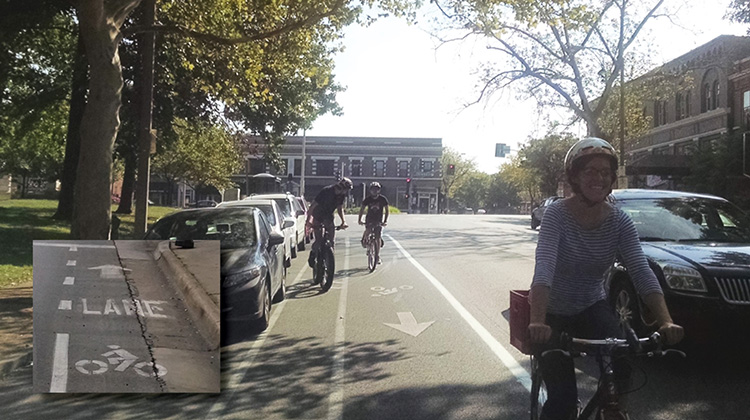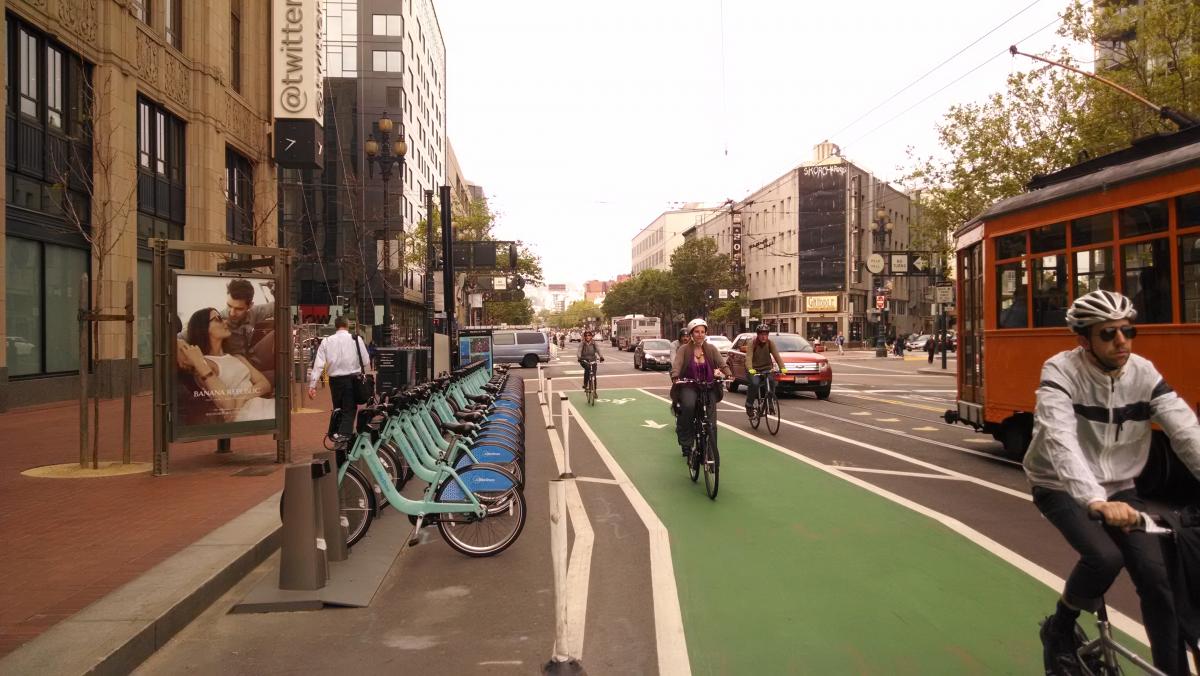DISCOVER YOUR LOCAL BICYCLING COMMUNITY
Find local advocacy groups, bike shops, instructors, clubs, classes and more!
5 Things I Learned As ‘BFC Steve’
 It’s official: The League reached 100 visits to communities across the country this year, helping them to create more bicycle friendly places for their residents. I completed 77 of those visits myself, so, as you can image, I have a lot of lessons to share.
It’s official: The League reached 100 visits to communities across the country this year, helping them to create more bicycle friendly places for their residents. I completed 77 of those visits myself, so, as you can image, I have a lot of lessons to share.
Here’s some of what I learned.
1) The League’s building blocks are key, but make sure they’re made of strong material!
A Bicycle Friendly Community is almost always characterized by having most, if not all of what the League has identified as the ten key Building Blocks. These are things like a Comprehensive Bicycle Master Plan, staff to implement the plan, and a strong network of bike facilities, policies and ordinances in place that will help institutionalize safe cycling. I found that, absolutely, these building blocks are indeed the DNA of a BFC.

But what my visits uncovered is that there can be huge differences in the quality of plans, staffing, policies and facilities. If all a community does is go through the motions of being able to check things off a prescribed list, it’s not going to result in the outcomes we’ve come to expect.
I’ve seen really amazing plans that aim to triple ridership and outline how to make that happen, and other plans that would seem to relegate bicycling as a marginal activity, limited to a few trails, without even mentioning how to make the street network safer for bicycling. Likewise there are really good facilities that encourage new riders like this one in St. Louis, MO (photo) and others that make one feel like a second-class citizen like this bike lane in Texas (inset).
2) It’s not what your city can do for bicyclists. It’s what bicycling can do for your city!
The places where great things are happening seem to have a very different orientation toward bicycling than the places where there’s resistance. Rather than viewing cycling as a special-interest activity, there’s a cultural awareness that bicycling epitomizes the very best of what a city can be — that perfect blend of social enhancement and physical utilitarianism; a device that Trek’s John Burke has aptly branded a “simple solution to many complex problems.”

Riders in Slow Roll in Detroit pose for a photo. Image courtesy of Slow Roll Detroit.
These are places like Salt Lake City, where Mayor Becker understands that bicycling will not only help improve the health of residents, but increase economic vitality, reduce traffic congestion, improve air quality and even help in the fight against climate change. The advocates in these cities don’t position themselves as a special-interest group fighting for a few feet here or a few feet there on the street, but act as part of a larger effort to make streets more livable, communities more vibrant and places more accessible for the benefit of all. The plans in these cities reflect the full potential of the bicycle with strong visionary statements, aspirational goals and concrete objectives to make it all come together.
3) Three legs do not make a stool
For a long time I’ve talked about the importance of having three entities in place for real change to occur: persistent and organized citizen advocates, enlightened and empowered elected officials and competent, dedicated staff. But it’s become clear that, while that might provide a good strong foundation for a stool, you still need the seat! And that comes from the bike shops.

Steve took a ride with local advocates during his visit to Atlanta, Ga.
It’s the bike retailers in a community that are on the front lines of the bicycling scene. It’s clear that most people involved in selling, fixing and customizing bicycles have seen what the bicycle can do for people, and are doing the work because they have a passion for it. Many of my visits were made possible only because the retailer in the area made it happen, and it was obvious once I got there that it was largely the store manager/owner who had been instrumental in getting things rolling in that community in terms of trails, bike lanes, events and educational activities.
Despite this, in many larger cities, there was often a total disconnect between the bike stores and City Hall. One of the greatest benefits of the BFC visits was in bringing the three legs of the stool together and joining them with the seat — solidifying better relations so that more good things could happen.
4) Hey advocates: BE BOLD!
When I was Bicycle Coordinator in Boulder, Colorado, I secretly helped to start an advocacy group so that I could be more effective in my position. I needed the advocates to be bolder than me, to allow for incremental change to occur. In a nut shell, their job was to make me look moderate.

Advocates rallied in New Orleans for better street conditions. Image courtesy of Bike Easy.
There is, of course, a fine line between being bold and being crazy — but it seems to me that far too many groups are so far from this line that they’re not providing the support or friendly agitation that staff need to get the job done. When I go into a city I look for signs of healthy tension; if the bike organization leaders have only positive things to say, and yet it’s clear that conditions for bicycling and walking are far from ideal, something is wrong. The relationship is further compromised if the advocates are dependent on contracts with the public agencies. It’s hard to be an effective voice when speaking out could hurt the operating budget of an organization.
On the other hand, advocates need to be quick to write letters of thanks and promote the positive as much as possible. If staff only hear complaints, that can be demoralizing. The key is to be respectfully relentless and to truly understand that your job is to reflect community values of good health, a vibrant economy, clean environment and transportation choices. Who could argue with any of that?
Well, the reality is if you’re doing anything to change the status quo, people will argue with it. And, let’s face it, most of us don’t really like conflict and the first sign of any opposition makes us fearful and we may feel like backing off. But opposition should be viewed as a positive sign. It truly should be seen as the best barometer that you are making a difference. And quite often, it’s only because of opposition that more people get involved and begin to understand what’s at stake.
I’ve gone places where a road diet has gone in and, despite reducing crashes and increasing bicycling, certain groups became mobilized and were able to get political leaders to retreat. But then that led to better mobilization among advocates and a backlash for the politicians who caved in to the “I like going fast in my car” crowd. The one step backward led to two or three steps forward. So again, be bold and embrace opposition as a sign you’re doing something that will make a difference.
5) Make the best option the easiest option.
Okay, I confess, this has been my mantra from the beginning, but certainly the visits this past year have reinforced it. The places that have the greatest number of people bicycling are places where it’s as easy or easier to ride as it is to get in a car. The places you rarely see another bicyclist are places where the infrastructure greatly favors the automobile. Almost always the most bicycle-friendly communities were places where Google maps showed me that the time it would take for me to get somewhere using a bicycle would be as fast or faster than driving a car.

A green lane in San Francisco
So, yes, land use is key. But it’s also critical to figure out how to provide advantages to people walking and bicycling. Davis, California, long ago realized that if they could give non-motorists short cuts by having trails connect the cul-de-sacs to schools and parks and other neighborhoods people might favor walking and bicycling. With 19% of people bicycling to work today, we can say they were indeed right.
Another way to provide advantages to bicyclists is with signal timing. It’s neat to see places in this country now attempting to put in place the Green Wave that Copenhagen has done — to time lights at a bicyclist’s speed. Bike sharing and parking policy can also make cycling more convenient (and far more economical) than driving. Finally, even conventional bike lanes that allow cyclists to legally pass slow-moving cars during rush hour can make it obvious to everyone that bicycling is the way to go.
But, of course, for any of these strategies to truly be effective, they need to be geographically dispersed throughout a community — accessible to all neighborhoods and key destinations. And people need to be aware of them! And while great things are happening throughout the nation, even the most bicycle friendly communities have a long ways to go before we can say conditions are optimum for walking and bicycling.
So here’s looking forward to 2015!
We’re now planning for the next 100 cities we will reach in 2015; if you hope your community could be one of the lucky places for a visit, please contact me with three reasons and you will be considered! Email me at [email protected].